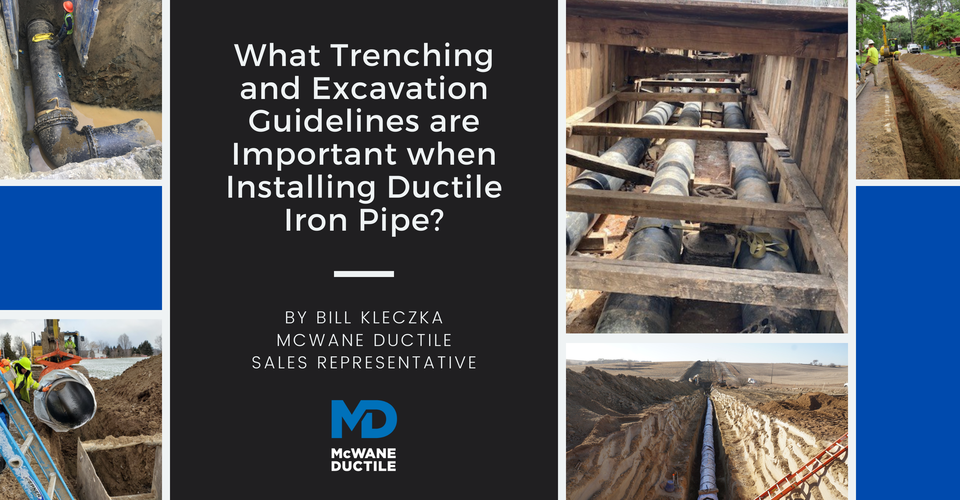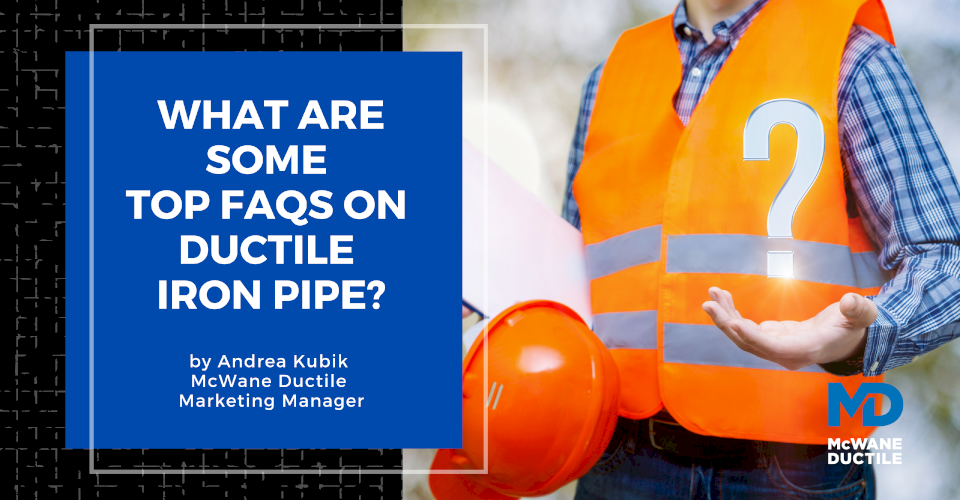-
Ask the Ditch Doctor - Does Internal Pressure Always Govern Ductile Iron Pipeline Design?
03/04/2022 In Ditch Doctor Installation TechnicalHave you ever been so taken aback by the structure of a question that your first thought is, “say what? Did they really just ask me that?” In the vernacular-sensitive world of utility pipelines, it happens more often than you might think.
-
How to Uninstall Ductile Iron Pipe Joints that Contain Locking Gaskets
01/27/2022 In Installation Products TechnicalHave you ever been on a Ductile iron pipe (DI pipe) installation with restrained joint gaskets and needed to uninstall a previously assembled joint? This is normally prompted by the need to replace a displaced or a “pinched” gasket. Proper gasket placement and attention during assembly is the best way to avoid such conditions, as detailed in a previous blog by McWane Ductile. Unfortunately, the problem often does not arise until the pipeline is hydrostatically tested. In today’s Iron Strong Blog, we will examine the “Dos & Don'ts" of uninstalling with DI pipe restrained joint gaskets.
-
What Trenching and Excavation Guidelines are Important when Installing Ductile Iron Pipe?
01/07/2022 In Environmental & Safety InstallationHave you ever been asked what size trench is needed when installing Ductile iron pipe (DI pipe)? How safe are the working conditions within a trench? Knowing the proper trench to utilize during the installation of the material will help save time, effort, and money on any job site. But most importantly, this knowledge will help keep everyone safe within and around the trench. The Occupational Health and Safety Administration (OSHA) has gone to great lengths to define and identify any threats in the trenching and excavation safety when installing DI pipe. This Iron Strong Blog will share and explain the different trenches available while outlining the safety considerations required when excavating earthen material.
-
How Do the Trench and Backfill Protect the Pipe?
12/02/2021 In Installation TechnicalUtility pipelines provide for some of the most basic needs within our society. Essential services, such as supplying potable drinking water to our homes and businesses or sending wastewater away, are possible because of a network of buried pipelines. Whatever pipeline materials are used, they are expected to meet minimum service qualities such as withstanding leakage. This resiliency to leakage eliminates waste of our precious drinking water and prevents polluted soils from wastewater in the pipeline's proximity.
-
Why Is Using the Right Design Criteria Important in Calculating Restraint Requirements?
11/19/2021 In Installation TechnicalWhen I first started my engineering career, I was placed in charge of coordinating the relocation of water transmission and distribution pipelines to accommodate the construction of an interstate highway through a city of approximately 180,000 residents. Many times, these projects required pre-poured thrust block restraints due to the amended connections between new and old waterlines in a short timeframe so as not to leave customers inordinately out of water for long periods of time.
-
The Iowa Treated Water Pipeline Project: Providing Growth with Safe, Clean Water
11/09/2021 In Installation ServicesShallow aquifers prone to contamination, compliance with federal drinking water standards, and insufficient resources to replace aging infrastructure. These are some of the water issues that launched the creation of the Lewis & Clark Regional Water System and the construction of the Iowa Treated Water Pipeline – Segment 3.
-
Hydrotesting on Slopes: The Hills Have PSI!
10/28/2021 In Installation TechnicalDear Ditch Doctor: Out here in the western United States, we wind up with a lot of pipelines installed up or down serious hills, dare I say mountains as well? We are good at the construction part, yet time after time we struggle with getting a satisfactory post-installation hydrostatic test on the pipeline, especially with inclined installations. Often the pipeline drops anywhere from 20 to 50 psi on the gauge and can do that several times or more until we take some sort of drastic redo/restart on the test procedures.
-
What are Some Top FAQs on Ductile Iron Pipe?
09/13/2021 In Installation Products TechnicalAs a manufacturer of Ductile iron pipe (DI pipe), we often field questions from water professionals regarding DI pipe, its uses, and how to install it properly. We even receive numerous questions about alternate materials, their differences, their uses, and the best choice for the application. And of course, when you ask, we answer…honestly, even when the answer doesn’t include Ductile iron. In this Iron Strong Blog, we’ll cover a few of our frequently asked questions (FAQ) and provide some solutions. We will continue with this FAQ series in the upcoming months.
-
Vicinity Energy Cuts Greenhouse Gases with Ductile Iron Pipe
08/27/2021 In Installation ProductsVicinity Energy, headquartered in Boston, Massachusetts supplies many downtown Baltimore, Maryland business corridor buildings with reliable central water services, offering a cost-effective alternative to maintaining in-house cooling equipment. In this Iron Strong Customer Spotlight, we’ll take a closer look at a recent Ductile iron pipe (DI pipe) installation project that will provide a means for sustainable, affordable energy in the Baltimore area for many years to come.
-
How to Minimize Jobsite Issues During a Pipeline Installation Project
08/20/2021 In Installation ServicesThe goal for every pipeline project is to install the pipe and related appurtenances successfully within the timeframe and budget that the contractor bid the project. Sometimes, however, issues arise that may cause potential delays. These delays can cost time and money. The good news is there are ways to help minimize these occurrences with proper training and product understanding. In this Iron Strong Blog, we will discuss how a project can get off to a good start and lead to a successful installation.
Latest Posts
- Developing an Asset Management Plan for Your Future Utility or Engineering Organization 12/04/2025 In Comparisons Industry
- Can Joining Water Works Industry Organizations Help You Grow Professionally? 10/21/2025 In Careers WaterWorks
- How Does Ductile Iron Pipe Provide Proven Resilience to Seismic Events? 09/04/2025 In Products Resiliency Technical
- How to Secure Green Reserve Sustainability Incentives Using State Revolving Funding & Ductile Iron Pipe 07/29/2025 In Energy Products Technical















